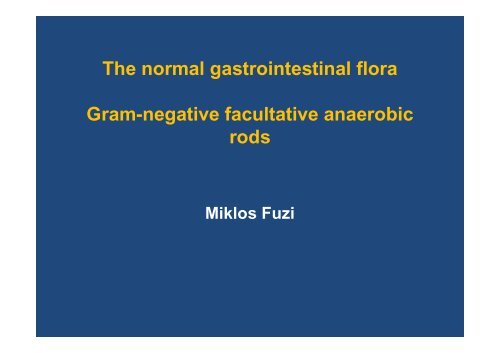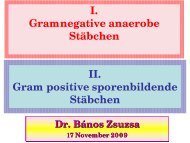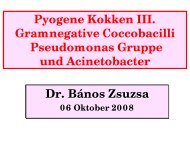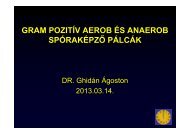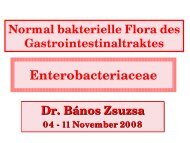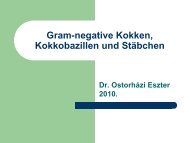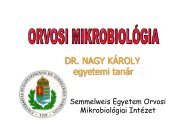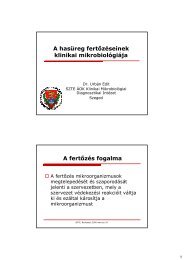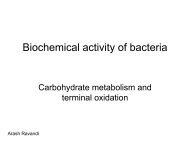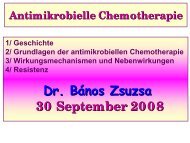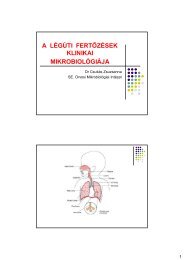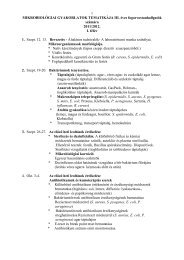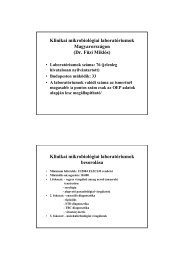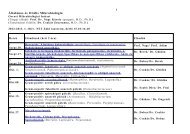Gram-negative facultative anaerobic rods
Gram-negative facultative anaerobic rods
Gram-negative facultative anaerobic rods
Create successful ePaper yourself
Turn your PDF publications into a flip-book with our unique Google optimized e-Paper software.
The normal gastrointestinal flora<br />
<strong>Gram</strong>-<strong>negative</strong> <strong>facultative</strong> <strong>anaerobic</strong><br />
<strong>rods</strong><br />
Miklos Fuzi
The normal human<br />
gastrointestinal flora<br />
• Comprises of 10 8 – 10 10 microbes/gram feces<br />
• Not just commensal but symbiotic relationship with host<br />
- fermentation of unused energy substrates<br />
- training of the immune system<br />
- preventing the growth of harmful, pathogenic microbes<br />
- producing vitamins<br />
- trophic effects<br />
- preventing allergy<br />
• Can become harmful<br />
- cause infections (if immune system is compromised)<br />
- increase cancer risk
The normal human<br />
gastrointestinal flora<br />
• Acquisition and composition of the normal flora:<br />
- following birth infants quickly acquire Escherichia<br />
coli and streptococci which generate an <strong>anaerobic</strong><br />
environment<br />
- in breast-fed infants a bifidobacterium flora<br />
establishes itself<br />
- in formula fed infants and in older children on solid<br />
diet other anaerobes:<br />
bacteroides (30%!), clostridia, fusobactria, peptococci<br />
and additional enterobacteriaceae colonize the gut<br />
- additional microbes: candida species, protoozoa
The impact of the intestinal flora<br />
on obesity<br />
An obesity-associated gut microbiome with<br />
increased capacity for energy harvest.<br />
Nature 2006, 444, 1027-31<br />
₺…colonization of germ-free mice with ‛obese<br />
microbiota’ results in a significantly greater<br />
increase in total body fat than colonization<br />
with a ‛lean microbiota’…”
Ingestion of lactobacillus strain regulates emotional<br />
behavior and central GABA receptor expression in a<br />
mouse via the vagus nerve<br />
Proc. Natl. Acad. Sci. USA 2011, 108, 16050-55<br />
₺ …alterations in central GABA receptor expression are<br />
implicated in in the pathogenesis of anxiety…”<br />
₺ …L. rhamnosus reduced stress-induced<br />
corticosterone and anxiety- and depression-related<br />
behavior…”<br />
₺… effects were not found in vagotomized mice…”
<strong>Gram</strong>-<strong>negative</strong> <strong>facultative</strong><br />
<strong>anaerobic</strong> <strong>rods</strong>: Enterobacteriaceae<br />
• Habitat: gastrointestinal tract of humans and<br />
animals<br />
plants<br />
soil<br />
• Grow on eosin methylene blue agar<br />
• No spore formation<br />
• Usually motile<br />
• Metabolism: - sugars are fermented<br />
- nitrate degraded to nitrites<br />
- catalase: variable<br />
- oxidase: <strong>negative</strong>
Enterobacteriaceae: most important genera<br />
• Escherichia:<br />
- The most abundant <strong>facultative</strong> <strong>anaerobic</strong> member of the human<br />
gastrointestinal normal flora<br />
- Produces vitamin K<br />
- Some types are enteric pathogens<br />
• Klebsiella: ankylosing spondilitis (HLA-B27); Crohn disease?<br />
• Enterobacter<br />
• Proteus: rheumatoid arthritis (amino acid sequence homology<br />
between the urease of P. mirabilis and the joint cartilage<br />
collagen)<br />
• Citrobacter<br />
• Serratia
Enterobacteriaceae:<br />
most important features<br />
- E. coli: production of indole from<br />
tryptophan<br />
- Klebsiella: degradation of urea<br />
- Enterobacter<br />
- Proteus: motile on solid media<br />
- Citrobacter<br />
- Serratia: production of pigment; capable<br />
of colonizing the respiratory tract<br />
2006. 03. 06.
Klebsiella<br />
pneumoniae<br />
Klebsiella<br />
oxytoca<br />
Enterobacter<br />
cloacae<br />
Identification of Enterobacteriaceae – first level<br />
Enterobacter<br />
aerogenes<br />
Serratia<br />
Pantoea<br />
agglomerans<br />
Hafnia<br />
Escherichia<br />
coli<br />
Motility - - + + + d d + + + + + + + + + + +<br />
H 2S - - - - - - - - - d + + - - - + + +<br />
Urease + + d - d d - - d d - - d + + + + +<br />
Indole - + - - - d - + + - - + + + + + - -<br />
Lysin-decar<br />
Lysin decar-<br />
boxilase<br />
Arginine-<br />
dihydrol. dihydrol<br />
Ornithin<br />
decarbox. decarbox<br />
Citrate<br />
Voges<br />
Proskauer<br />
Citrobacter<br />
koseri<br />
+ + - + + - + + - - + + - - - - - -<br />
- - + - - - - d d d d - - - - - - -<br />
- - + + + - + d + - + + - - + - + -<br />
+ + + + + d - - + d + - + + - d d -<br />
+ + + + + d d - - - - - - - - - d -<br />
Pigment - - - - d d - - - - - - - - - - - -<br />
Ferment: Ferment<br />
- Adonit + + d + d - - - + - - - - + - - - -<br />
- Inositol + + d + d d - - - - d - + + - - - -<br />
- Lactose + + + + d d - + d d - - - - - - - -<br />
-Mannitol Mannitol + + + + + + + + + + + - - + - - - -<br />
Saccaharose + + + + + d - d d d - - d d - + - +<br />
Polymyxin-B Polymyxin S S S S R S S S S S S S R R R R R R<br />
2006. 03. 06.<br />
Citrobacter<br />
freundil<br />
Salmonella<br />
Edwardsiella<br />
Providencia<br />
stuartil<br />
Proteus<br />
rettgeri<br />
Proteus<br />
morganil<br />
Proteus<br />
vulgaris<br />
Proteums<br />
mirabilis<br />
Proteus<br />
penneri
mirabilis<br />
vulgaris<br />
Morganii<br />
ssp.morganii<br />
Identification of proteus and providencia spp.<br />
Proteus Providencia<br />
morganii<br />
ssp.sibonii<br />
rettgeri<br />
inconstans<br />
Urease + + + + + - + + + - - - -<br />
Indole - + + + + + - - + + + + -<br />
2006. 03. 06.<br />
panneri<br />
myxofaciens<br />
stuartii<br />
biocsoport<br />
4<br />
stuartii<br />
biocsoport<br />
5<br />
stuartii<br />
biocsoport<br />
6<br />
H 2S + + - - - - d - - - - - -<br />
Methyl red + + + + + + + + + + + d +<br />
Voges-Proskauer<br />
Voges Proskauer d - - - - - - + - - - - -<br />
Gelatine + + - - - - d + - - - - -<br />
Phenylalanine-<br />
deaminase<br />
Omithine- Omithine<br />
decarboxylase<br />
Prod. Prod.<br />
of gas from<br />
glucose<br />
Fermentation<br />
+ + + + + + + + + + + + +<br />
+ - + + - - - - - - - - -<br />
+ + + + d d d + - - - d -<br />
- Glucose + + + + + + + + + + + + +<br />
- Adonit - - - - + + - - - - + - +<br />
- Inositol - - - - + - - - - + + - d<br />
- Maltose - + - - - - + + - - - - d<br />
- Mannitol - - - - + - - - - - - - -<br />
- Mannose - - + + + + - - + + + + +<br />
- Rhamnose - - - - d - - - - - - - +<br />
- Trehalose + d - + - - d + + + + - -<br />
- Xylose + + - - - - + - - - - - -<br />
rustigianii<br />
heimbachae
Eosin-methylene blue agar<br />
Selective and differentiating medium:<br />
- Eosin and methylene blue inhibit the growth of<br />
<strong>Gram</strong>-positive bacteria<br />
- Anionactive detergent (eg. Na-laurylsulphate)<br />
inhibit the swarming of proteae<br />
- Contains lactose. Bacteria degrading lactose<br />
produce acid that precipitates eosin that will be<br />
stained by methylene blue → the colonies of<br />
lactose positive bacteria are blue those of the<br />
lactose <strong>negative</strong>s are pink or grayish<br />
- Advantage: acid will be formed just under<br />
colonies<br />
2006. 03. 06.
Eo<br />
E. coli<br />
E. coli<br />
Br<br />
2006. 03. 06.<br />
VA
SSI Bi VA<br />
Klebsiella<br />
DC EM Br
Proteus growing on eosin methylene blue<br />
agar
Klebsiella growing on blood agar plate<br />
2006. 03. 06.
Proteus
Serratia marcescens growing on<br />
blood agar plate
Enterobacteriaceae extraintestinal<br />
infections<br />
Most frequent nosocomial infections<br />
- Surgical wound infection<br />
- Urogenital infection /often catheter associated/<br />
- pneumonia /ventilation/<br />
- Meningitis<br />
- Sepsis<br />
Most frequent community-acquired infections<br />
- Urogenital infections /E. coli/<br />
- Pneumonia /klebsiella/<br />
- Otitis externa /infection of the external auditory<br />
canal/<br />
2006. 03. 06.
Uropathogenic E. coli<br />
• Causes 90 per cent of community-acquired urethral<br />
and bladder infections<br />
• Source of infection: normal GI flora<br />
• Infection is more frequent in women<br />
• Infection can be ascending resulting in<br />
pyelonephritis, prostatitis<br />
• Uropathogenic strains harbour special virulence<br />
factors
Uropathogenic E. coli<br />
• Characteristics of uropathogenic strains:<br />
- have „P” fimbriae that specifically bind to<br />
P blood group antigens which are present<br />
also on the surface of uroepithelial cells<br />
- produce haemolysins which damage also<br />
epithelial cells<br />
- capable of forming „colonies” inside human<br />
cells (hiding from immune response)
Enterobacteriaceae: Antibiotic<br />
resistance<br />
Most frequently used agents:<br />
- Cephalosporins<br />
- carbapenems<br />
- aminoglycosides<br />
- fluoroquinolones<br />
Most important mechanisms of resistance<br />
- Production of β-lactamase<br />
- Efflux systems<br />
- Alteration of membrane proteins<br />
- Production of modifying enzymes<br />
- Mutations in target molecules<br />
2006. 03. 06.
β-lactamase enzymes<br />
• Large family of enzymes<br />
• Many bacteria produces β-lactamases including free-living<br />
species<br />
• Grouping: on the basis of structure or efficacy<br />
• Some members of the family enterobacteriaceae<br />
constitutively produce „simple” β-lactamases the genes of<br />
which are usually located on the chromosome<br />
• As a consequence of extended use of antibiotics a number<br />
highly effective variants of the original β-lactamases evolved<br />
in recent decades
β-lactamase enzymes<br />
The most important types of β-lactamases:<br />
- extended-spectrum β-lactamases (ESBLs): klebsiella, E. coli<br />
- genes located on plasmids (easily transmit)<br />
- confers resistance against penicillins and most<br />
cephalosporins<br />
- metallo-β-lactamases (MBLs): klebsiella, pseudomonas<br />
- genes are located on plasmids or on the chromosome<br />
- confer resistance against all β-lactam antibiotics<br />
including carbapenems
Significance of enteritis<br />
• Estimated to cause 1.6 – 2.1 million deaths<br />
annually all over the world (prior to the<br />
introduction of rehydration with glucoseelectrolyte<br />
solution at the beginning of the<br />
1980s the figure could have been twice as<br />
high)<br />
• Deaths occur mostly in children<br />
• Geographical distribution of cases:<br />
Most affected areas: „black Africa”, India,<br />
Southeast Asia
Conditions promoting the development<br />
of enteric disease<br />
• Lack of safe drinking water (a problem for 30-<br />
35% of humanity)<br />
• Lack of appropriate sanitation (affects about<br />
50% of humanity)<br />
• Lack of appropriate food higyene<br />
• Lack of appropriate cleaning facilities<br />
• High density of population, crowded<br />
residential area
The consequences of recurrent enteric<br />
infections in childhood<br />
• Growth retardation due to malabsorption (average:<br />
8.2 cm until 7 years of age; later the child can catch<br />
up some growth retardation if infections seize)<br />
• An intellectual retardation of about 10 IQ points (The<br />
brain and synapses develop primarily during the first<br />
two years of life)<br />
• A weakened immune system („Fitness cost”<br />
associated with a predisposition to infections)<br />
• Infection with particular pathogens <strong>negative</strong>ly impact<br />
development even without enteric symptoms<br />
(enteroaggregative E. coli, cryptosporidium)
Genetic susceptibility to infection by<br />
enteropathogenic bacteria<br />
• Salmonella: some IL, HLA, IFNGR genes,<br />
TNFA<br />
• Helicobacter pylori: some IL genes, IFNGR1,<br />
TNFA<br />
• Vibrio cholerae O1: blood group 0<br />
• Clostridium difficile: IL-8<br />
• Enteroaggregative E. coli: IL-8
E. coli causing enteritis<br />
• Strains of E. coli can acquire pathogenicity factors<br />
carried on plasmids or other mobile genetic elements and<br />
become enteropathogenic<br />
• Types of E.coli causing enteritis:<br />
- Enteropathogenic E. coli (EPEC)<br />
- Enterotoxin producing E. coli (ETEC)<br />
- Enteroinvasive E. coli (EIEC)<br />
- Enterohaemorrhagic E. coli (EHEC)<br />
- Enteroaggregative E. coli (EAEC)<br />
• Types can not always be distinguished: pathogenicity<br />
factors can vary across groups<br />
• Pathogenicity factors are linked to particular O serotypes<br />
in all groups
Enteropathogenic (dyspepsia) E. coli (EPEC)<br />
• Causes disease primarily in children less than 1 year<br />
old<br />
• Capable of adhering to the epithelial cells of the<br />
small intestine by its pathogenicity factor: „intimine”<br />
• Symptoms: can be serious or mild<br />
• Pathogenicity is related to certain O serotypes<br />
• Earlier caused outbreaks in day care centres fro<br />
young children<br />
• Therapy: fluid replacement<br />
when symptoms are serious antibiotics
Enterotoxin producing E. coli (ETEC)<br />
• The causative agent of „travellers’ diarrhea” prevalent in<br />
developing countries<br />
• symptoms: serious „watery diarrhea”; affecting the small<br />
intestine<br />
• Pathogenicity factors: usually located on plasmids<br />
• Serotypes: diverse<br />
• Identification: demonstration of pathogenicity genes with<br />
PCR → underdiagnosed<br />
- adhesion factors (colonization factors) –<br />
usually on fimbriae; types sepcific for particular animal<br />
species exist<br />
- toxins: LT (heat labile), ST (heat stable)<br />
• Therapy: antibiotics, fluid replacement
Enteroinvasive E. coli (EIEC)<br />
• Symptoms are same as those of shigellosis (bloody<br />
diarrhea - dysentery)<br />
• EIEC strains carry the same virulence plasmid and<br />
virulence genes as shigellae<br />
• EIEC strains are often lactose <strong>negative</strong> and nonmotile<br />
• EIEC O antigens are also related to those of<br />
shigellas<br />
• Transmission: food, contact (not as efficient as with<br />
shigellas)<br />
• Most common serogroup: O124
Enterohaemorrhagic E. coli (EHEC)<br />
• Symptoms: -serious bloody enteritis, affecting<br />
primarily the colon<br />
-haemolytic uremic syndrome<br />
(HUS): haemolytic anaemia with acute<br />
renal failure<br />
• Transmission: food (beef, milk), contact<br />
• Pathogenesis:<br />
- adhesion factors<br />
- toxins: „Shiga-like” (SLT) – damaging capillaries;<br />
transmitted by phages; demonstration: PCR<br />
• Most important serotype: O157 – strains usually<br />
sorbitol <strong>negative</strong><br />
• Therapy: antibiotics, fluid replacement
Enteroaggregative E. coli (EAEC)<br />
• Attachment to epithelial cells is associated with the<br />
aggregation of the bacteria<br />
• Symptoms: serious watery diarrhea<br />
chronic diarrhea<br />
• Pathogenicity factors: pili, fimbriae<br />
• The fimbriae aggregate human collagen, fibronectin,<br />
laminin<br />
• Identification: demonstration of pathogenicity<br />
factors by PCR → underdiagnosed
Yersinia enterocolitica<br />
• Motile, lactose <strong>negative</strong> coccobacilli<br />
• Many serotypes: mainly the O3 and O9 strains are<br />
widespread in Europe<br />
• Symptoms: diarrhea, swelling of lymphatic glands, ileitis<br />
terminalis<br />
• Reservoir: animal, human<br />
• Transmission: contact, food<br />
• Pathogenicity: adhesion proteins<br />
• Secondary „autoimmune” sequel: arthritis<br />
• Diagnosis: culture of Y. enterocolitica on selective media<br />
• Therapy: antibiotics
Vibrionaceae family<br />
• Most important group: Vibrio genus<br />
• Curved <strong>Gram</strong>-<strong>negative</strong> <strong>rods</strong>, motile, oxidase positive<br />
• Natural habitat: saline-, sweet waters<br />
• Strains can be grouped on the basis of salt<br />
requirement:<br />
halophilic, non-halophilic strains<br />
• Vibrios are usually susceptible to acidic environment<br />
but tolerate alkaline pH well (characteristic used for<br />
isolation)
Vibrio cholerae<br />
• Most important species in the genus Vibrio<br />
• On the basis of O antigen more than 100 serogroups<br />
are recognized; all carry the same flagella antigen<br />
• Large epidemics are caused by serogroups O1 and<br />
O139<br />
• The O1 strains have two biotypes:<br />
- classic<br />
- El Tor<br />
• Both groups are subdivided according to the<br />
structure of the O antigen for serotypes: Ogawa,<br />
Inaba, Hikojima
Vibrio cholerae<br />
• Natural habitat: sea (Banghlades), lives<br />
in copepods (crustacean); dormant<br />
form survives for months in the<br />
sediment of estuaries<br />
• Transmission: water, food (many<br />
bacteria are required for infection)<br />
• Epidemics: often pandemics (prevalent<br />
in India, black Afrika, South-America)
Cholera (1)<br />
• Incubation: from a few hours to a couple of days depending<br />
on the number of infecting bacteria<br />
• Symptoms: serious watery diarrhea, desiccation occurs<br />
within hours often causing hypovolaemic shock<br />
• Pathogenesis:<br />
- the pathogen attaches to the epithelial cells of the small<br />
intestine with its adhesins.<br />
- produces cholera toxin (coded for by a phage<br />
inserted in the chromosome) – similar to the heat labile<br />
toxin of the ETEC strains.<br />
Toxin’s pathomechanism: activation of adenylate cyclase,<br />
cAMP accumulated within cells → escape of ions, water
Cholera (2)<br />
• Diagnosis: isolation of the pathogen<br />
Medium: TCBS – tiosulphate-citrate-bilesaccharose<br />
Enrichment: alkaline peptone water<br />
• Therapy: quick fluid and salt replacement<br />
antibiotics (tetracycline)<br />
• Vaccine: of limited value
Vibrio colonies on TCBS agar
Other vibrios<br />
• Halophile vibrios – require salt for growth<br />
• Important species:<br />
V. parahaemolyticus<br />
V. vulnificus<br />
• Transmission: not sufficiently heat treated sea food<br />
swimming in sea water<br />
• Symptoms: usually not serious<br />
• Skin/wound infection does occur
Campylobacter genus<br />
• <strong>Gram</strong>-<strong>negative</strong> curved <strong>rods</strong>; motile<br />
• Require microaerophilic atmosphere<br />
• Oxidase positive<br />
• Relevant species: C. jejuni, C. coli, C. fetus, C. lari<br />
• Habitat: animals<br />
• Transmission: contact, food<br />
• Symptoms: variable (can be serious)<br />
• Culture: on selective medium in microaerophilic<br />
atmosphere at 42 C<br />
• Therapy: macrolide, fluoroquinolone antibiotics<br />
• Secondary autoimmune sequel: Guillain-Barre<br />
syndrome
Campylobacter - <strong>Gram</strong> stain
Colonies of campylobacter on selective medium
Recorded cases of campylobacterosis in the United<br />
Kingdom<br />
Annual number of cases in Hungary: about 6000
Helicobacter pylori<br />
• <strong>Gram</strong>-<strong>negative</strong> curved <strong>rods</strong>, sometimes assume<br />
non-culturable coccoid forms<br />
• Microaerophilic<br />
• Motile<br />
• Oxidase and catalase positives<br />
• Strongly urease positives – ensures survival in acidic<br />
gastric environment<br />
• Strains harbouring the „Cag pathogenicity island”<br />
are the most virulent (type IV secretion system;<br />
CagA protein)
Helicobacter pylori<br />
• About 50% of humanity carries H. pylori<br />
• Carriage is symptomless in about 80% of cases<br />
• Conditions caused by H. pylori<br />
- gastritis<br />
- ulcer<br />
- gastric carcinoma<br />
- MALT (mucosa-associated lymphoid tissue)<br />
lymphoma
Helicobacter pylori<br />
• Culture: sample to be taken into transport medium<br />
Isolation: on selective medium (similar to<br />
campylobacter agar), at 37 C microaerophilic<br />
atmosphere<br />
• Diagnosis: urease breath test (UBT) – labelled urea swallowed;<br />
exhaled labelled carbondioxide detected<br />
detection of antigen in feces (ELISA,<br />
latex)<br />
detection of antibody from urine or blood<br />
(ELISA)<br />
isolation of pathogen from gastric biopsy<br />
sample – when determination of antibiotic<br />
resistance is necessary<br />
demonstration of H. pylori DNA in gastric<br />
biopsy sample by PCR
Therapy:<br />
Helicobacter pylori<br />
- cephalosporins<br />
- macrolides<br />
Resistence is not rare!<br />
Proton pump inhibitors<br />
Extended, repeated treatment
Helicobacter pylori
Helicobacter pylori: pathogenicity
Helicobacter pylori on gastric<br />
epithelial cells
Thank you for your attention


